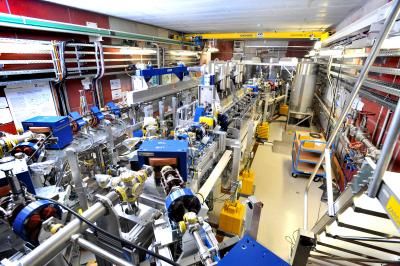A quick look at electron-boson coupling
Berkeley Lab researchers use ultrafast spectroscopy on many body effects
Imagine being able to tune the properties of a solid material just by flashing pulses of light on it, for example turning an insulator into a superconductor. That is just one potential payoff down-the-road from the physical phenomenon of electrons and atoms interacting with ultrashort pulses of light. The technology of ultrafast spectroscopy is a key to understanding this phenomenon and now a new wrinkle to that technology has been introduced by Berkeley Lab researchers.
In a study led by Alessandra Lanzara of Berkeley Lab's Materials Sciences Division, time- and angle-resolved photoemission spectroscopy (trARPES) was used to directly measure the ultrafast response of electron self-energy - a fundamental quantity used to describe "many-body" interactions in a material – to photo-excitation with near-infrared light in a high-temperature superconductor. The results demonstrated a link between the phenomena of electron-boson coupling and superconductivity. A boson can be a force-carrying particle, such as a photon, or composite particle of matter, such an atomic nucleus with an even number of protons and neutrons.
"Below the critical temperature of the superconductor, ultrafast excitations triggered a synchronous decrease of electron self-energy and the superconducting energy gap that continued until the gap was quenched," says Lanzara. "Above the critical temperature of the superconductor, electron–boson coupling was unresponsive to ultrafast excitations. These findings open a new pathway for studying transient self-energy and correlation effects in solids, such as superconductivity."
The study of electrons and atoms interacting with intense, ultra-short optical pulses is an emerging field of physics because of the roles these interactions play in modulating the electronic structures and properties of materials such as high-temperature superconductors. ARPES has been the long-standing technique of choice for studying the electronic structure of a material. In this technique, beams of ultraviolet or X-ray light striking the surface or interface of a sample material cause the photoemission of electrons at angles and kinetic energies that can be measured to reveal detailed information about the material's electronic band structures. While extremely powerful, ARPES lacks the temporal component required for studying band structural dynamics.
Lanzara and a collaboration that included Wentao Zhang, lead author of a paper on this work in Nature Communications, added the necessary temporal component in their trARPES study. They applied this technique to a material known as Bi2212, a compound of bismuth, strontium, calcium, and copper oxide that is considered one of the most promising of high-temperature superconductors. They energized the Bi2212 samples with femtosecond pulses of near-infrared laser light then probed the results with femtosecond pulses of ultra-violet laser light. The delay time between pump and probe pulses was precisely controlled so that the electron-boson coupling and the superconducting gap could be tracked at the same time.
"In cuprate materials such as Bi2212, there is a known kink in the photoemission pattern that signifies the coupling of the electrons to bosons," says Zhang. "However, whether this kink is related in any way to superconductivity has been highly debated. Our results show that it is."
Other news from the department science
Most read news
More news from our other portals
See the theme worlds for related content
Topic World Spectroscopy
Investigation with spectroscopy gives us unique insights into the composition and structure of materials. From UV-Vis spectroscopy to infrared and Raman spectroscopy to fluorescence and atomic absorption spectroscopy, spectroscopy offers us a wide range of analytical techniques to precisely characterize substances. Immerse yourself in the fascinating world of spectroscopy!

Topic World Spectroscopy
Investigation with spectroscopy gives us unique insights into the composition and structure of materials. From UV-Vis spectroscopy to infrared and Raman spectroscopy to fluorescence and atomic absorption spectroscopy, spectroscopy offers us a wide range of analytical techniques to precisely characterize substances. Immerse yourself in the fascinating world of spectroscopy!






























































